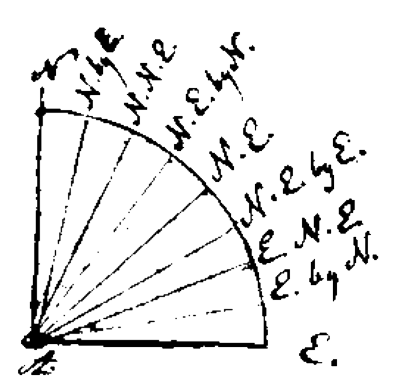June 16, 1832
16 June: Today is the thirtieth day since we left Helvoet. Weather a little better. We can sit on deck, which, however, the water still strikes now and then. A strong, cool northwest wind is blowing somewhat against us, and we can go sailing only toward the southwest. High seas. Single Procellaria hover around us. Noon observation: latitude 41°28', longitude 43°40' west. Temperature of the air (of the cold wind) 11°R [56.8°F, 13.8°C], of the water 14°R [63.5°F, 17.5°C. Skipper Robbins explained this great discrepancy between the temperature of the air and that of the water as a result of the warmth of the water from the Gulf Stream flowing from the Gulf of Mexico. This may well be correct, for this warm current extends as far as the region south of the Newfoundland Bank, exactly where we are now.
All afternoon a strong northwest wind blew, which drove the sea ahead very hard against us. It was high and frequently splashed onto the deck. Whenever the steeply heeling ship quickly hastened in bounds through the high, wild waves and plunged into the water, the sea rushed outward as far as 40 paces on both sides, completely beaten into white foam. All the waves of the dark lead-colored ocean that rolled toward us were capped with white foam.
Behind the ship, above the smooth, white-streaked wake that every vessel leaves behind it, as many as twenty small petrels (Procellaria pelagica) hovered incessantly and often came very close to us. Unfortunately, up to now we could not get a single bird since it has been impossible to lower a boat.
The ship is sailing rather rapidly today. Unfortunately, we cannot steer north and westward, because of the completely contrary wind. A ship of considerable size cannot advantageously sail more than 2 points by a contrary wind. Small ships, such as boats and the like, probably move 5 points, in the most extreme case, 6 points by the wind, as in the example here in the adjacent diagram. The entire wind 〈[compass]〉 rose has 32 points; that is, each quarter of 90°, or the right angle, has 8 points. Assuming that the wind is blowing from the north and the ship is situated at ‘A,’ it can sail only 2 points, hence in the direction east-northeast; small ships perhaps up to 5 or 6 points, hence in the direction northeast by north or, at the most, north-northeast.
The entire wind 〈[compass]〉 rose has 32 points; that is, each quarter of 90°, or the right angle, has 8 points. Assuming that the wind is blowing from the north and the ship is situated at ‘A,’ it can sail only 2 points, hence in the direction east-northeast; small ships perhaps up to 5 or 6 points, hence in the direction northeast by north or, at the most, north-northeast.
The evening was nice, but there was a very strong, cool wind, which drove the sea high against the ship. Procellaria pelagica behind the ship in large numbers. At night, little wind; we rested undisturbed.


